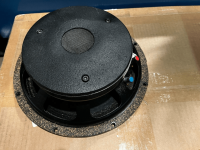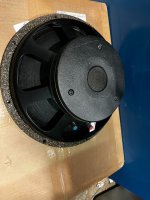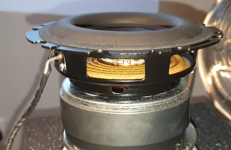One other thing I have notice din your simulations. You have a throat that couples to your driver. The volume of the throat has to allow excursion that you are accepting as real, the full area of the driver at least at the entry point for the drivers cone. Depth of your rear chamber. That's another one that is not making sense in the one simulation that I ran with the 18Sound driver. 7.5 cm is just shy of 3 inches. I'm pretty sure that the driver is deeper than that. When you account for all the small details I have found that Hornresp is rather accurate. When I have not taken these things into account I generally find out that re-simulating as built will get me quite close to what I measure.
Wow. THIS is what I have been looking for! I knew there had to be some spec that indicated how quick a woofer was. Very insightful with the Klippel data to back it up. Thank you!Yes, but need to understand that it's the inductance that governs transient response.
Had a conversation with Mark (Kravchenko_Audio) and exploring a tapped horn with the PA310-8. I plugged away on some sims and this might be an option. There were some good designs out there, I have to make sure the horn expands. I started with volvotreter's design with the AWM104 as a layout:
https://volvotreter.de/wp-content/uploads/2016/04/AWM104_TH_Rev_0.pdf
My plan was to expand it vertically to increase the height for expansion. Then reconfigure the output port so it fires out large flat side instead of straight up from the skinny side. On paper, it looks like a rocky ride, but extends out way past 300hz. The plots show 2.86V in grey and 20V in red. I simulated it with a low pass 2nd at 180hz and high pass 4th order at 30hz. Then added a notch filter at the 40hz peak. Having tapped horn to 300hz doesn't look pretty, but it may actually work
https://volvotreter.de/wp-content/uploads/2016/04/AWM104_TH_Rev_0.pdf
My plan was to expand it vertically to increase the height for expansion. Then reconfigure the output port so it fires out large flat side instead of straight up from the skinny side. On paper, it looks like a rocky ride, but extends out way past 300hz. The plots show 2.86V in grey and 20V in red. I simulated it with a low pass 2nd at 180hz and high pass 4th order at 30hz. Then added a notch filter at the 40hz peak. Having tapped horn to 300hz doesn't look pretty, but it may actually work
Attachments
-
 Screenshot from 2023-11-17 17-24-08.png6.9 KB · Views: 62
Screenshot from 2023-11-17 17-24-08.png6.9 KB · Views: 62 -
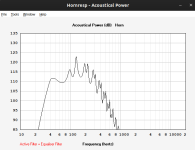 Screenshot from 2023-11-17 17-23-56.png7 KB · Views: 42
Screenshot from 2023-11-17 17-23-56.png7 KB · Views: 42 -
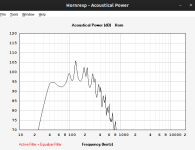 Screenshot from 2023-11-17 17-23-30.png7 KB · Views: 42
Screenshot from 2023-11-17 17-23-30.png7 KB · Views: 42 -
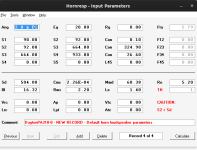 Screenshot from 2023-11-17 17-23-14.png7.2 KB · Views: 43
Screenshot from 2023-11-17 17-23-14.png7.2 KB · Views: 43 -
 Screenshot from 2023-11-17 17-22-56.png9.6 KB · Views: 50
Screenshot from 2023-11-17 17-22-56.png9.6 KB · Views: 50 -
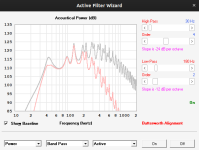 Screenshot from 2023-11-17 17-22-43.png9.3 KB · Views: 62
Screenshot from 2023-11-17 17-22-43.png9.3 KB · Views: 62 -
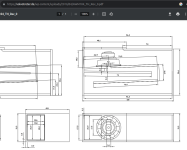 Screenshot from 2023-11-17 17-03-29.png32.6 KB · Views: 63
Screenshot from 2023-11-17 17-03-29.png32.6 KB · Views: 63
In my haste I forgot to convert the 'con' specs to 'par', though of course is acoustically insignificant with these basic designs; also didn't include any power/BW robbing inductance/thermal power distortion that will narrow up its Fhm = 2*Fs/Qts' gain BW that only goes to ~269 Hz, so real world will likely be somewhat less.........
.....unless for wide high gain BW increase the end loaded TH's mouth area 6x/~500 L for an averaged 100 dB/m/2pi out past 300 Hz and hopefully this will be enough to keep most of its HF BW intact.
.....unless for wide high gain BW increase the end loaded TH's mouth area 6x/~500 L for an averaged 100 dB/m/2pi out past 300 Hz and hopefully this will be enough to keep most of its HF BW intact.
Where the mouth is will be rather important. As close as is possible to the horn. The trouble with the tapped horn is that they do sometimes have wider bandwidth than we simulate. I have used this driver before, and it is a decent midrange. Might get up high enough.
Yeah, some of DSL's for sure do, but I'm stuck with basic theory, HR programming  since I only cobbled together one POC Unity concept way back when TD gave me a few suitably vague hints of his new patent in a late '90s PM and would probably never figured it out had I not been familiar with building one of these early on in my 'adventures' in DIY audio.
since I only cobbled together one POC Unity concept way back when TD gave me a few suitably vague hints of his new patent in a late '90s PM and would probably never figured it out had I not been familiar with building one of these early on in my 'adventures' in DIY audio.
 since I only cobbled together one POC Unity concept way back when TD gave me a few suitably vague hints of his new patent in a late '90s PM and would probably never figured it out had I not been familiar with building one of these early on in my 'adventures' in DIY audio.
since I only cobbled together one POC Unity concept way back when TD gave me a few suitably vague hints of his new patent in a late '90s PM and would probably never figured it out had I not been familiar with building one of these early on in my 'adventures' in DIY audio.Oh wow, I get it, the second uses the dts style folding scheme. Brilliant. I’ll explore this approach. Thank you!Basic ~32 Hz TH, ~32 Hz DTS
With Black Friday sales at Parts Express, I resisted the temptation to go buy the two PA310's and instead get a DATS V3 to test what I have and use for future projects anyway. I have two very nice prosound woofers similar to a number of prosound woofers used for horns like evm15l / EVm12l:
I figure I measure those for exact specifications and use that to test some concepts with various enclosures as OSB is cheap. That being said, I could at least test two combinations to determine what direction to go:
So - I'll measure these woofers and see what is possible. Thanks for the help everyone!
- RENKUS-HEINZ SSL 15-6 - 15" Woofer / (Same as McCauley B1540)
- RENKUS-HEINZ SSL 12-7 - 12" woofer / (Same is McCauley M1220)
- 4" apple homepod high excursion woofer (maybe a flat an skinny tapped horn, like various exodus anarchy tapped horn designs) It's impressive with regard to excursion! ()
I figure I measure those for exact specifications and use that to test some concepts with various enclosures as OSB is cheap. That being said, I could at least test two combinations to determine what direction to go:
- Cram as much bandwidth as possible into a front speaker. (using the 12" tapped horn)
- Optimize a front loaded horn from 80-400hz (12" woofer) and have a sub (15") cover under the 80hz. (I have a rear corner, two spaces under a couch, and an entire crawlspace underneath where I could add fake air conditioner vents for the sub vents).
So - I'll measure these woofers and see what is possible. Thanks for the help everyone!
Attachments
Ok Some advice for the DATS. It can be quite the variable piece of test equipment. So give it time to charge up, and do an average of tests with a few minutes in-between.
The design work that Greg did will need to be tweaked to use it with your drivers.
That Apple driver looks interesting. Is quiet. The excursion is about 6mm. A lot less than it appears to have. You need to pay attention to the driver scale and the actual movement on the tinsel leads to the voice coil.
The design work that Greg did will need to be tweaked to use it with your drivers.
That Apple driver looks interesting. Is quiet. The excursion is about 6mm. A lot less than it appears to have. You need to pay attention to the driver scale and the actual movement on the tinsel leads to the voice coil.
Thanks! I’ve tweaked around with his design, learning more on hornresp. I gather to aim for flat low end while peaks and valley will not be so great in reality. The impedance peaks get really high, not sure if that is going to be of a concern. With the DATS at least I’ll know what I have and see if it works in a sim and give that tapped horn a try for this range first. The 12” I have on hand is quite narrow depth wise. This came off the loudpseaker with the cdt-1 point source mid/tweeter coentrant horn.
With understanding your impedance and T/S parameters you can design or have designed for you an enclosure that will perform as simulated in Hornresp. You can verify that by testing the enclosure with your DATS and then comparing the position of the impedance peaks to the simulation. The magnitude will always be different as Hornresp does not account for any loses in it's simulation. There are always losses mechanically in an enclosure.
I investigated a concept of a dual CBT style array to accomplish my 40-400hz goals in a separate thread. It would use the side wall to mirror image the complete CBT array, similar to Keele's CBT design. Maybe it could explain why large mouth horns sound dynamic? The idea is to use MCM 6.5" woofers (or whatever is around under $15 each) in a 2 x 8 array.
See the thread here:
https://www.diyaudio.com/community/...nd-reproduction-in-rooms.408106/#post-7573941

See the thread here:
https://www.diyaudio.com/community/...nd-reproduction-in-rooms.408106/#post-7573941
Bought some Renkus-Heinz speakers for the 15" woofers to match the woofer I have now, the 15" McCauley. It turns out it also uses different woofers, the 18Soudn 15w700, which is a good woofer. Troelsgravesen uses it up to 650hz on the Loudspeaker-III kit and he claims this has amazing bass. http://www.troelsgravesen.dk/The-Loudspeaker-III.htm
Using his box tuning and 225L enclosure volume gave a good sim in HornResp with very low group delay.






The impulse response is best I have seen for a reflex cabinet:

adding an active low pass 1st order filter plus the parameter EQ in middle flattens it out.

Phase it not really affected:

Efficiency is high for bass reflex where it counts too:

He already provides a port design using a slot. I may investigate a port that has low turbulence, which can be done if you have a tapered port, like the TDS-Sub apparently has. A research paper talked about optimizing designs for ports that I'll look into: https://stars.library.ucf.edu/cgi/viewcontent.cgi?article=1956&context=honorstheses
While I would like a horn for midbass, I find it difficult to keep within the size parameters and maintain a good phase response, step response, and group delay for other designs. I attempted to make a front-loaded horn for it, but it affected the low-end bass tuning and group delay.
At least I can use this as a starting point. The controlled phase, group delay, roll-off, etc.. theoretically can allow for better integration to subs. If going this route, I would look into multiple sealed subwoofers using Alpine Type-R subwoofers, or tapped horns under the floor venting into the room. Theoretically, I would make a low slope 12db crossovers for sub-integration.
Using his box tuning and 225L enclosure volume gave a good sim in HornResp with very low group delay.
The impulse response is best I have seen for a reflex cabinet:
adding an active low pass 1st order filter plus the parameter EQ in middle flattens it out.
Phase it not really affected:
Efficiency is high for bass reflex where it counts too:
He already provides a port design using a slot. I may investigate a port that has low turbulence, which can be done if you have a tapered port, like the TDS-Sub apparently has. A research paper talked about optimizing designs for ports that I'll look into: https://stars.library.ucf.edu/cgi/viewcontent.cgi?article=1956&context=honorstheses
While I would like a horn for midbass, I find it difficult to keep within the size parameters and maintain a good phase response, step response, and group delay for other designs. I attempted to make a front-loaded horn for it, but it affected the low-end bass tuning and group delay.
At least I can use this as a starting point. The controlled phase, group delay, roll-off, etc.. theoretically can allow for better integration to subs. If going this route, I would look into multiple sealed subwoofers using Alpine Type-R subwoofers, or tapped horns under the floor venting into the room. Theoretically, I would make a low slope 12db crossovers for sub-integration.
Parts Express is having a clearance sale on the 18" PN470-8 for $149 each + an ADDITIONAL 25% off at checkout. Grand total of $247 for the pair including free shipping. Looks like a really good driver for the $$$.

Seems well behaved under 500hz, the 18" cone could match the directivity of the mid-hi horn if I run it to cross at 400hz, has a natural acoustic roll-off at that point.

Here's a comparison to the grey (PN470-8) tuned to 33.9 vs 15W700 tuned to 20hz.
Better extension to 30hz by 6db.

Excursion down by 50%

Phase shifted up a little.

group delay shifted up, but under 23 msec around 32hz, very reasonable performance across the entire band:

impulse is much tighter for PN470-8:

Here's the power conversion efficiency PN470-8 (grey) looks much higher in the 20-80hz range vs the 15W700 vented.

I could take the 15W700 woofer and use it as a midbass in a sealed Q-.5 cabinet (black plot), I get higher efficiency in the 90-500hz plot. I have another prosound 12" driver I may consider as well.

So the system so far would be at minimum:
high/mid - unitized image waveguide to 450hz.
bass - 18" PN470-8 woofer in 270L cabinet, tuned to 33.9hz. 20-450 hz.
IF I make it a 4-way, then add:
midbass - 15" 18sound 15w700 in sealed cabinet 150hz -450hz (may jsut have natural low freq roll off with 1st order high pass around 40hz.
Seems well behaved under 500hz, the 18" cone could match the directivity of the mid-hi horn if I run it to cross at 400hz, has a natural acoustic roll-off at that point.
Here's a comparison to the grey (PN470-8) tuned to 33.9 vs 15W700 tuned to 20hz.
Better extension to 30hz by 6db.
Excursion down by 50%
Phase shifted up a little.
group delay shifted up, but under 23 msec around 32hz, very reasonable performance across the entire band:
impulse is much tighter for PN470-8:
Here's the power conversion efficiency PN470-8 (grey) looks much higher in the 20-80hz range vs the 15W700 vented.
I could take the 15W700 woofer and use it as a midbass in a sealed Q-.5 cabinet (black plot), I get higher efficiency in the 90-500hz plot. I have another prosound 12" driver I may consider as well.
So the system so far would be at minimum:
high/mid - unitized image waveguide to 450hz.
bass - 18" PN470-8 woofer in 270L cabinet, tuned to 33.9hz. 20-450 hz.
IF I make it a 4-way, then add:
midbass - 15" 18sound 15w700 in sealed cabinet 150hz -450hz (may jsut have natural low freq roll off with 1st order high pass around 40hz.
Last edited:
I am using two PRV 18SW2200, each in a 7 cubic foot box tuned to 41 hz. In room they get to 28 hz. They barely move and they knock everything off of shelves, tables and the **** upstairs. They should do 135 db and stay within XMAX. Probably overkill for what you want but I would guess the 15SW2000 would be plenty for you in a 4 cubic foot box.
Nice! The specifications look similar to the PN470-8. MY design seems to mimic what you are experiencing, where the cones should barely move as listening volumes. I really, wanted to keep the speaker within minimum xmax across operating range. Do you get good tight bass at low listening volumes too? What are you running for mids/highs? BTW - nice user name. Rush fan? 
Yes, even at low levels you can feel it. These things are hard to play low level. 100db 1w1m. I usually listen around 90 to 100 db. At about 105 db and up ( at listening position. About 12 feet) things start falling off the shelves. This is actually in a PA I built for my band. I am using two Dayton PA310s for mids and a JBL 220Ti. Crossed at 250 hz and 1600 hz. And yes, big Rush fan!
- Home
- Loudspeakers
- Multi-Way
- High WAF Dynamic Speaker System Build
